ZSU 3.7 cm FlaK auf Fahrgestell Panzerkampfwagen IV (sf) / Möbelwagen (Germany)
Work on the creation of self-propelled anti-aircraft based on the tank Pz.Kpfw.IV started at the beginning of 1943 year. The industry has already mastered the mass production of such tanks, which allowed them to be used as the basis for new armored vehicles. In addition, the use of such a chassis made it possible to achieve maximum unification with front-line equipment and thereby facilitate operation. Also, unified chassis allowed self-propelled guns to operate freely in some combat formations with tanks.
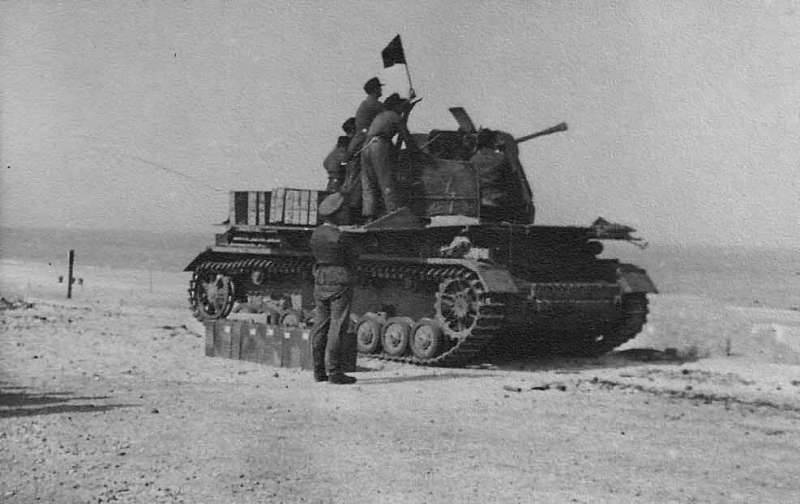
Möbelwagen at the front. On the site and on the ground are boxes with shell clips. Photo Worldwarphotos.info
At the very beginning of 1943, Krupp began work on a relatively simple ZSU project based on a production tank. With the machine Pz.Kpfw.IV it was proposed to remove the tower and mount a solid roof. It, in turn, should have installed a quad-mounted automatic cannon Flak 38, known as 2 cm Flakvierling 38. Such a system could fire at a practical rate of fire to 700-800 shots per minute and hit targets at ranges of the order of 2-2,2 km. Thus, a promising self-propelled gun had the ability to deal with various modern anti-Hitler coalition aircraft.
The project of a similar ZSU, designated 2cm Flakvierling auf Fahrgestell Panzerkampfwagen IV, was presented to the army. In the first months of 1943, the company-developer built a prototype of such a machine and conducted its tests. The checks were successful, but the military was not interested in such a proposal. Some features of the proposed machine did not suit the potential customer, because of which in mid-May the project was officially closed.
One of the complaints about the 2cm Flakvierling auf Fahrgestell Panzerkampfwagen IV project concerned the use of 20-mm guns. Even with four automatic weapons, the firepower of the self-propelled gun might not be enough to solve some problems. In addition, the prospective enemy aircraft could be too difficult a target for 20-mm guns. For this reason, it was decided to continue the development of the existing project by using the new weapons with higher performance. The new version of the anti-aircraft armored vehicle was proposed to be equipped with an automatic gun caliber 37 mm.
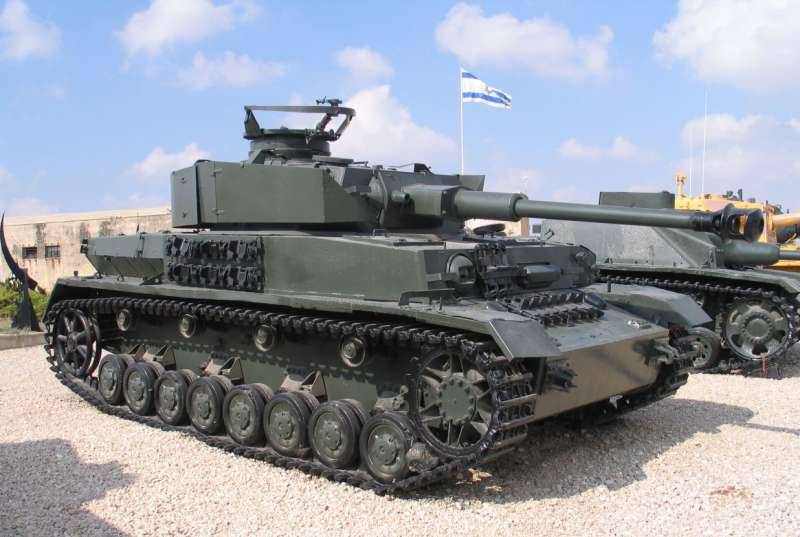
Tank Panzerkampfwagen IV, which became the basis for a whole series of ZSU. Wikimedia Commons Photos
The basis of the promising ZSU, as in the case of the previous project, was to become a serial medium tank Pz.Kpfw.IV. For the installation of tools and auxiliary equipment, he had to lose some units, first of all towers with all the appropriate equipment. In addition, on the podbashennoy box should be mounted solid armor sheet roof, serving as a support for weapons. The rest of the body of the tank remained the same, which, among other things, allowed to build self-propelled self-propelled guns on the basis of tanks of various modifications.
During the modernization of the new project, the base tank retained the armor hull with homogeneous protection up to 80 mm thick. The corps had a traditional German tank layout with a front control compartment, a central combat compartment and aft engine compartment. At the same time, part of the transmission units was moved forward and tied to the engine using a propeller shaft. After installing the roof inside the hull of the prospective ZSU, there remained a relatively large space that was proposed to be used for the transportation of various cargoes, primarily ammunition.
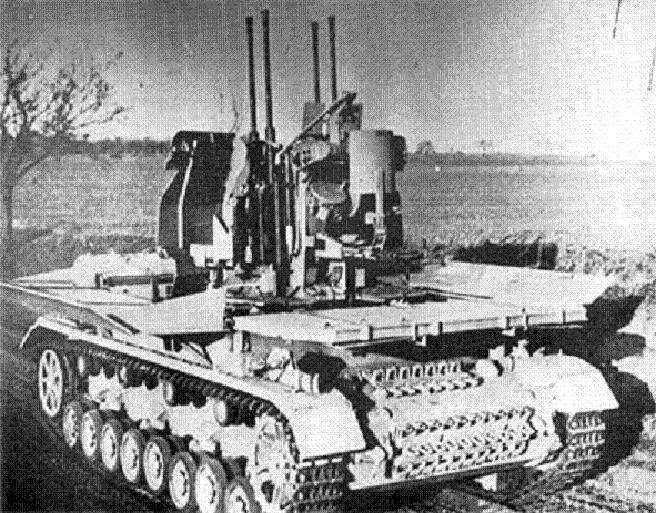
The first version of the ZSU based on Pz.Kpfw.IV, equipped with quad installation with 20-mm guns. Photo Aviarmor.net
Tanks Pz.Kpfw.IV equipped with gasoline engines of various types with power from 250 to 300 HP With the help of a cardan shaft passing through the central part of the body, torque was transmitted to the main clutch connected to the manual gearbox. Depending on the modification of the tank used five or six-speed gearbox. Transmission transmitted torque to the drive wheels of the front location.
The undercarriage of the tank and, accordingly, the new self-propelled gun had eight small compact wheels on each side. The rollers were installed in pairs on balancers with leaf springs. Driving wheels were placed in the front of the hull, guides - in the stern. To support the upper branch of the caterpillar there were several rollers.
During the rework, the tank was to lose the tower and get a new roof. In addition, as in the case of the previous project, the use of armored cutting was envisaged. Above the sides, as well as in front and behind, the platform for the instrument had to be covered by folding armor plates with a thickness of 25 mm. In the stowed position, the sheets rose to a vertical position and formed a duct covering the gun and its calculation from bullets and fragments. During combat work, the sheets should be lowered into a horizontal position, after which they did not interfere with the movement of the instrument, and also formed a platform for calculation. In addition, it was possible to maintain protection during the shooting. To this end, swinging devices of a complex shape were provided on the front and stern sheets, with the help of which it was possible to fix the beads in an inclined position, increasing the available space for the calculation.
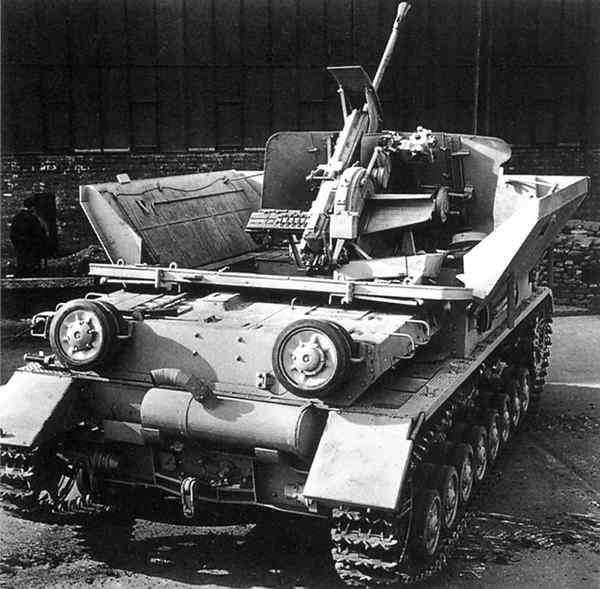
Self-propelled gun in the fighting position: the tailgate is lowered, the side ones are set at an angle, the gun is raised. Photo Aviarmor.net
As the main weapon for attacking air targets, the 37-mm Flak 43 automatic gun was chosen. In the center of the upper platform of the hull, it was necessary to install the installation, which would provide guidance of the gun in a circle and with elevation angles up to 90 °. The installation was equipped with manual guidance drives. There was a shield to cover the gunners from the shelling in front, equipped with a movable gun mask.
The FlaK 43 cannon was supposed to use 37x263 mm B ammunition with several types of shells. She had a 37-mm barrel length 57 calibers. Automatics based on a gas engine made it possible to fire at a technical rate of fire up to 250 shots per minute. However, due to the use of an ammunition system based on clips with 8 shells, the practical rate of fire could not exceed 150-170 rounds per minute. Depending on the type of projectile, the initial velocity was 770-820 m / s. Effective firing at air targets was provided at distances of no more than 4,5-4,8 km, at ground targets - up to 6,5 km. In several packings inside the case, it was possible to place the ammunition as part of 52 clips with 416 shells.
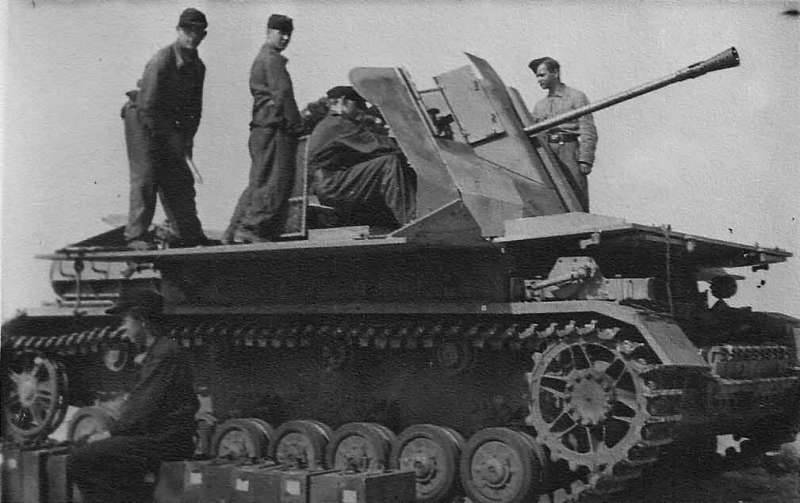
Self-propelled gun while shooting. All sides are lowered and form a platform for the work of gunners. Photo Worldwarphotos.info
The new anti-aircraft self-propelled project also provided for the use of additional weapons. It was proposed to place the MG34 machine gun with ammunition in the styling of the hull. In addition, the crew could have personal weapons, which also should be used for self-defense.
The crew of the self-propelled gun consisted of six people. Two of them, a driver and a radio operator, were located in front of the hull. Others (commander, gunner and shells carriers) were to be placed and work on the gun platform. Their task was the operation of weapons and the implementation of various operations for its maintenance. According to other data, the crew was supposed to consist of four or seven people, depending on the assigned combat mission.
The combat weight of the new ZSU reached 26 m. The length of the vehicle did not exceed 6 m, width 3 m, height –2,7 m. The 300-strong engine could accelerate the self-propelled gun to 38 km / h. Fuel tanks with a total volume of 470 l allowed to go to 200 km on the highway or 130 km on the road.
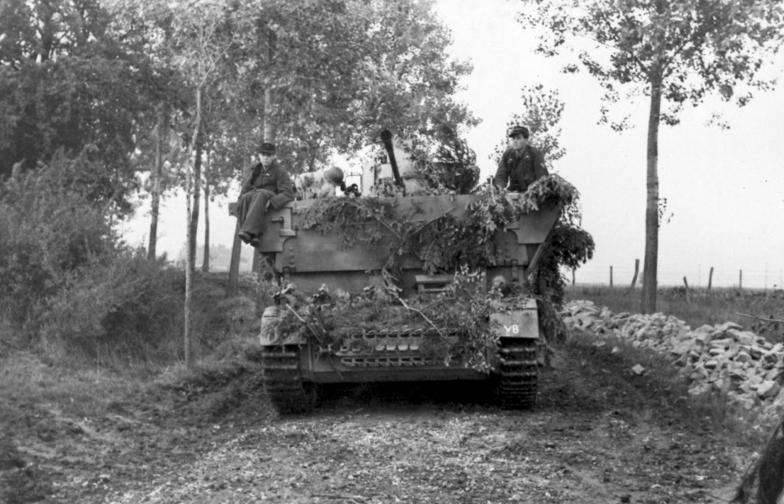
"Furniture van" in Normandy, 1944 g. Photo by Wikimedia Commons
The new project, taking into account the basic components, received the official designation 3.7 cm FlaK auf Fahrgestell Panzerkampfwagen IV (sf). In addition, by analogy with previous developments, the alternative designation Flakpanzer IV was introduced - “Anti-aircraft tank based on Pz.Kpfw.IV”. However, a similar name was applied to other vehicles based on this medium tank. The project received the unofficial nickname Möbelwagen (“Wardrobe for furniture”). The appearance of such a name has contributed to the form of armor felling guns in the stowed position.
In October 1943, the company Krupp assembled the first prototype of a new self-propelled anti-aircraft installation. Perhaps it was based on the chassis, which was used as the basis for the previous prototype with four 20-mm guns. In early December, “Van for furniture” was shown to the country's leadership, after which it determined its further fate. In view of the temporary lack of alternatives, it was decided to adopt the new machine and deploy its mass production. The corresponding order appeared at the end of January 1944.
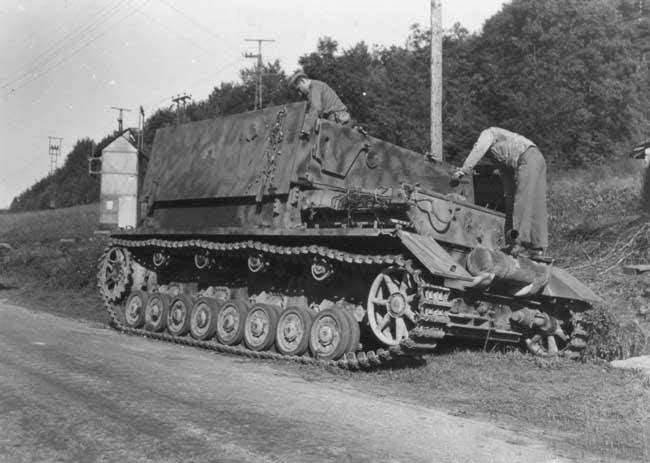
Armored car at the front. Photo Aviarmor.net
The production of machines was entrusted to the enterprises of Deutsche-Eisenwerke and BMM. It was planned to launch the assembly of machinery in February, but in fact it began only in March. In order to save manpower and resources, as well as to avoid reducing the supply of armored vehicles to the front, it was decided to abandon the construction of tracked chassis specifically for assembling ZSU. Instead, it was proposed to use the tanks available in the troops. Some of the armored vehicles of the Pz.Kpfw.IV type arriving to the rear were supposed to undergo repairs and receive new weapons, changing their role on the battlefield. This approach to the production of self-propelled guns allowed to reduce costs, as well as speed up the necessary work.
The first 3.7 cm FlaK auf Fahrgestell Panzerkampfwagen IV (sf) serial machines were built by the beginning of April 1944. After some checks, two dozen cars went to the troops. In mid-June, this equipment was delivered to Western Europe and transferred to one of the units already engaged in hostilities. In the future, production and delivery of self-propelled guns continued.
ZSU Flakpanzer IV was produced during the year. The assembly of the first machines of this type began in March 1944, and the latest serial self-propelled guns left the assembly shops in March of the 45. Due to some technical and technological limitations, the two contracting plants for the year managed to build only 240 (according to other data, 250) “Vans for furniture”. All this equipment was sent to various anti-aircraft units of armored forces. Deliveries were made mainly in units fighting in Western Europe. Since the opening of the Second Front, the Allied forces seized the initiative in the air, as a result of which German troops suffered heavy losses from aviation and needed means of protection against such threats.
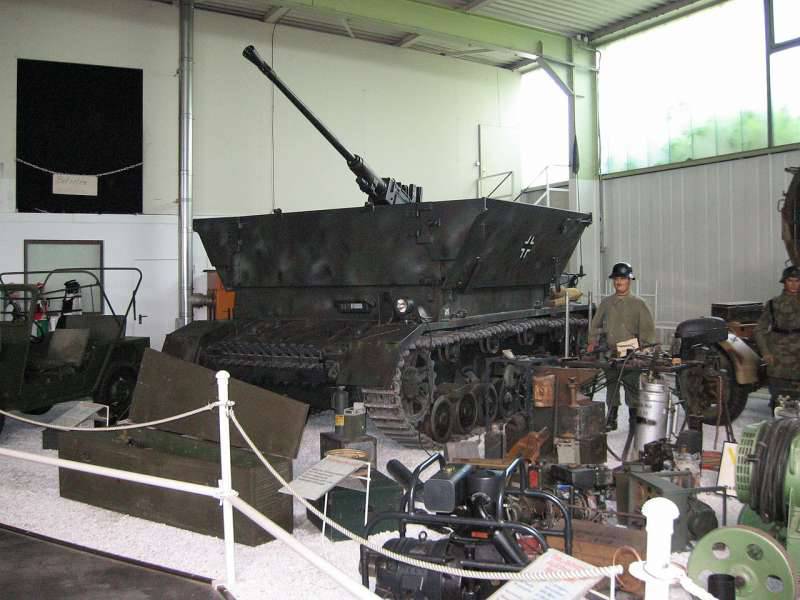
The only surviving sample in combat configuration. The logging sides are fixed at an angle. Wikimedia Commons Photos
The operation of the 3.7 cm FlaK auf Fahrgestell Panzerkampfwagen IV anti-aircraft self-propelled gun (sf) continued until the very end of the war in Europe. Such equipment, being a significant threat to the aviation of the anti-Hitler coalition, was at particular risk, which led to serious losses. However, by the end of the war at least a few dozen self-propelled guns remained in the ranks. After the end of hostilities they became trophies of the allies. Due to the development of the resource and the lack of serious prospects, almost all of these machines were disposed of as useless. Only one sample of the Möbelwagen machine has been preserved, which is now stored in one of the German museums.
Since the beginning of 1943, the German industry has been working on the creation of promising self-propelled anti-aircraft installations based on the Pz.Kpfw.IV medium tank. The first result of these works, which reached mass production and operation in the army, was the “Van for furniture”. Soon there were several other projects that are often referred to by the general name Flakpanzer IV. According to some reports, the 3.7 cm FlaK auf Fahrgestell Panzerkampfwagen IV (sf) machine was launched into the series as a temporary solution in anticipation of a newer technology with enhanced performance. In practice, the production of Flakpantser-4 several options for several months was conducted in parallel.
ZNU 3.7 cm FlaK auf Fahrgestell Panzerkampfwagen IV (sf) became the founder of a whole family, and also remained in stories as the most massive of his representative. Nevertheless, two and a half hundreds of combat vehicles could hardly have a serious impact on the course of hostilities. New technology with enhanced characteristics appeared quite late, which did not allow it to seriously delay the defeat of Nazi Germany.
On the materials of the sites:
http://aviarmor.net/
http://achtungpanzer.com/
http://armor.kiev.ua/
http://wehrmacht-history.com/
http://panzerworld.com/
Information